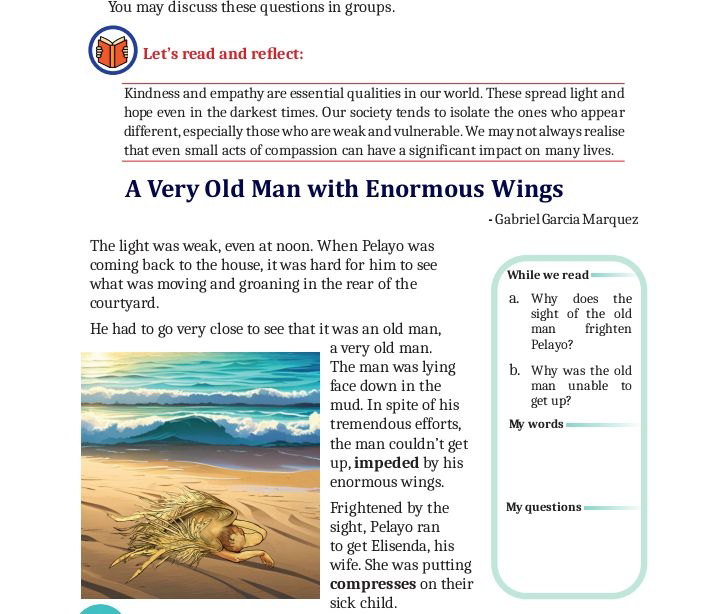Death The Leveller
1. Why does the poet think that the glories of our blood and state are shadows?
The poet thinks that the glories of our blood and state are shadows because they are not substantial or concrete things. They don’t last.
2. What do ‘sceptre and crown’ and ‘scythe and spade’ stand for and what do they symbolize?
Sceptre and crown stand forthe royal glory, splendour and power of rulers. Scythe and spade stand forthe tools of workers. Sceptre and crown symbolizes kings (authority) whereas scythe and spade symbolize ordinary people (the masses).
3. Why does the poet say that ‘there is no armour against fate’?
The poet says that ‘there is no armour against fate’ because death comes to everyone. Nobody can resist it. No armour will protect you against death.
4. ‘Some men with swords may reap the field’- What does this mean?
It means some powerful conquerors might attack other lands and occupy them. Alexander the Great, Napoleon and Hitler are good examples of such mighty men.
5. What is the fate of the men with swords who hope to reap the field?
They also die, as they have to bend before fate. All are captives of the mighty Death.
6. What does ‘Death’s purple altar’ refer to?
It refers to the inevitable death. It also refers to the battle grounds where blood flows and the ground are made purple with the colour of blood. Thus it means bloodshed.
7. What does the phrase ‘victor-victim’ mean?
It is means the conqueror and the conquered, the triumphant and the defeated, the master and the slave.
8. What can survive death ? What are the things that blossom in the dust? Why?
The actions of the just, the good deeds of the righteous people, can survive death. The good actions blossom in the dust because people will remember them and the aroma of the good actions will continue to waft in the air.
9. Why death is called the Leveller?
Death is called the Leveller because Death shows no distinction and he carries off everybody alike – high and low, rich and poor, strong and weak – reducing them all to dust. He is an equalizer in whose eyes everybody is equal. He levels everybody to one size.
Activity - II (Read And Reflect)
Elaborate the ideas in the following lines:
i) Only the actions of the just Smell sweet and blossom in the dust.
All people have to die. Kings and clowns, scholars and illiterates, rich and poor, high and low – all will die and become dust. But the actions of the good people will be remembered as they continue to waft their aroma even from the dust.
ii) The glories of our blood and state
Are shadows, not substantial things;
There is no armour against Fate.
The glory or our birth and our condition are simply like shadows, not substantial, not concrete, not things that will last for long. There is no way we can escape from death. Whether we are born high or low, whether we are powerful or not death will come to us and no shield of any kind will protect us from death.
The following words are taken from the poem. Parse (Describe the grammatical function) them.
- Armour – noun
- wither – verb
- But – Conjunction
- tame – verb
- Murmuring – adjective
- stoop – verb
- Boast – verb
- tumble – verb
- Where – adverb
- reap – verb
- Cold – adjective
- boast – verb
- Sweet – adverb
- bleeds – verb
Activity - III (Analysis)
Examine the rhyme scheme of the poem. What effect does it produce?
The rhyme scheme of the poem is: ababccdd It give the poem a highly musical quality.
Couplet: A couplet consists of two lines of poetry that rhyme with each other and are of the same length: e.g. “Sceptre and crown Must tumble down,”
Can you identify more couplets from the poem?
a) “Early or late ,
They stoop to fate”
b) “ murmuring breath
creep to death”
c) “actions of the just
blossom on their dust”
Figures Of Speech : Study the notes given on page 69.
Identify the figure of speech in ‘Death lays icy hands on kings’ – Personification Pick out example of metaphor, metonymy and oxymoron in the poem.
Metaphor:
i) glories are shadows. It shows the transient and insubstantial nature of glory.
ii) Actions of the just smell sweet: The actions of the just are flowers.
Metonymy :
i) sceptre and crown means kings, rulers or people with high authority.
ii) scythe and spade = ordinary people
Oxymoron : victor-victim bleeds. Normally it is only the victims that bleed.
Activity - IV (Appreciation)
Men are mortal. Triumph and failures are part and parcel of life. However, we have to think of the consequences of our action before we do something. The effect of our mistaken deeds cannot often be rectified.
Think and add your views : Life is a mixture of pleasure and pain. There are ups and downs in everybody’s life. We should not be overjoyed in our success. In the same way we must feel too dejected in our failures. We have opportunities to do good and bad. If we do good things, posterity will remember us as good people. But if we do bad things, people will curse us even after our death. So our aim should be to live exemplary lives and help others to live their lives in a good way.
Now attempt and appreciation of the poem
The poem ‘Death the Leveller’ by James Shirley is a fine poem that teaches us a god lesson. It says that our earthly glories are mere shadows. There is no shield against Fate. Death comes to all. Even the mightiest will be levelled with the poorest by Death, who is a leveller. Some men may make big conquests but their strong nerves finally become weak. Finally they also die as poor, pale prisoners of fate. So do not boast about your great actions. On the altar of death victor and the vanquished bleed alike. However great you are, your head must come to the cold tomb. Only the good actions of the just people will be remembered by posterity.
The poem has fine imagery. The poet has used many figures of speech like simile, metaphor, metonymy and oxymoron. These figures make the poem very interesting. The poem is in rhyme with the scheme ababccdd. It has a fine rhythm and it is very melodious.
The poem has a fine message: Death levels everyone. He treats all alike. All, kings and clowns, scholars and the illiterate, the rich and the poor, end up in dust. So we should not boast about our capabilities and achievements. We should remember that all of us are children of God and we all go back to the same dust. Death is a great leveller.



Thank you so much
ReplyDeleteThis very usefull
Super
Delete